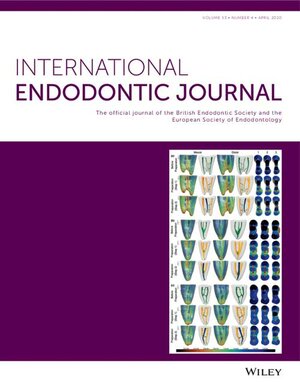Two- and three-dimensional healing assessment after endodontic microsurgery in through-and-through periapical lesions: 5-year follow-up from a randomized controlled trial
Abstract
Aim
To evaluate clinical and radiographic outcome of endodontic microsurgery in through-and-through periapical lesions at 1-year and 5-year follow-up with adjunct use of platelet-rich plasma (PRP).
Methodology
Thirty-two patients with large through-and-through periapical lesions were randomized in platelet-rich plasma (PRP) group and control group. Two-dimensional (2D) healing was evaluated with Molven's criteria and three-dimensional (3D) healing with modified PENN 3D criteria. Healing at resection plane (R), apical area (A), buccal cortex (BC), palatal cortex (PC) and overall bone healing (B) was assessed using CBCT scans. The volume of lesion was measured using ITK-Snap software. The analysis included comparison of 1- to 5-year intragroup (Friedman test/McNemar test) and intergroup scoring (Chi-square/ Mann–Whitney test). Logistic regression analysis was performed to determine the effect of various factors on healing at 5 years.
Results
Out of 32 patients/59 teeth evaluated after 1-year of endodontic microsurgery, 24 patients/44 teeth reported at 5 - year follow-up. Healing assessment with modified PENN 3D criteria revealed improvement in overall success rate of 66.7% at 1 year to 83.3% at 5 years, with no deterioration in any healing category. PRP group exhibited significantly better 3D healing than control group; both at 1 year (84.6% vs. 45.5%) and 5 years (100% vs. 63.6%). A significantly higher number of completely healed teeth were observed in PRP group than the control group at 5 years with respect to R, BC and B parameters. A volume reduction of 88% (91.4% PRP, 84% control) was depicted at 1 year and 94% (97.1% PRP, 91.1% control) at 5 years. None of the recorded factors including age, gender, size of lesion, preoperative swelling and sinus, histology of lesion, use of PRP, tooth location, preoperative buccal bone had significant effect on 3D healing at 5 years.
Conclusions
This 5-year study suggested improvement in 3D radiographic healing of large through-and-through periapical lesions from 1 to 5 years with no deterioration in any healing parameter in both control and PRP groups. The additional use of PRP led to significantly better healing in such lesions. RACB index using CBCT allows better estimation of healing at resected, apical and cortical plane over modified PENN 3D or Molven's criteria.

 求助内容:
求助内容: 应助结果提醒方式:
应助结果提醒方式:


